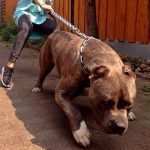
St Bernards and Poodles are among the two most popular breeds of dogs. St Bernards are known for being “gentle giants” while the Poodles have been praised a lot for their elegance and classy looks.
These dogs are very different from each other in terms of looks. What will happen if we combine these two? Get to know more about the St Bernard Poodle mix in today’s post.
Appearance
This designer dog is among the unique-looking Doodles. It is without a doubt the largest of them all! It looks a lot like its St Bernard parent, with its brown and white coat but displays the beautiful curly coat texture of a Poodle. If you have a thing for dogs that look a lot like real-life teddy bears, you will definitely not regret having this dog around. Who would say no to a big buddy with a sweet face?
A typical Saint Berdoodle can grow as heavy as 200 pounds, and stands up to 27 inches tall. Its weight and height are close to the measurements of a St Bernard. Like the latter, some could weigh even more than 250 lbs. Poodles can be medium to large but they are twice smaller than St Bernards because they can only grow up to 24 inches and 70 pounds at maximum.
As with most Doodle mixes, the St Bernard-Poodle cross inherits the Poodle’s hypoallergenic coat. This makes the dog the best option for people suffering from pet allergies. Poodles are often bred with other breeds of dogs because of their non-shedding features. It’s not that they don’t shed at all. It’s just that their loose hair only gets trapped in their curls and that gives the impression that they are a non-shedding breed.
Grooming
Like their parent breeds, these dogs may be a bit challenging to groom because of their rough and dry coat. Just imagine the Saint Bernard’s long and wavy coat becoming a bit wiry like the Poodle’s! You will eventually need a spray bottle filled with water to dampen the dog’s coat during the grooming session. Once it’s damp, you can finally work your way on the strands using a pin brush.
When grooming, it’s best to begin from the shoulders and move all the way to the body. Once you get to the bigger areas like the legs and the tummy, brush the coat using a slicker brush. Compared to a pin brush, it has finer bristles which make it ideal for getting rid of knots and tangles.
Personality
This dog is a combination of two large breeds known for their gentle nature and calm temperament. Both dogs are loving and affectionate and will do anything to please their owners. Because of this, these two well-loved breeds are ideal as family pets. Both are friendly towards other people, though St Bernards are usually friendlier with pets and strangers.
Although it is big, a St Berdoodle can easily adjust even in apartments and houses without a large yard. Due to their massive size, they have restricted movement and you cannot expect them to run a lot or play around the same way smaller dogs do. Don’t expect them to be efficient as watch dogs despite theirsize. Their big appearancemay be intimidating but don’t expect them to display aggression. They seldom bark even towards people they’ve just met.
Health
The “St Berdoo” may benefit from heterosis or hybrid vigour. This refers to improved features said to have been a result of crossing two different breeds. Still, there is a possibility it will inherit some of the conditions common to both parent breeds. Some health problems often seen in both the Saint Bernards and the Poodles include:
Bloating – giant dogs are prone to bloating mainly because of their unusual built. These dogs can easily suffer from this condition due to the broadness and deepness of their chest. To prevent bloating, allow your St Berdoodle to rest for an hour before and after feeding. Don’t feed one large meal at a time because this puts the dog at a larger risk of developing bloating.
Allergies – both Poodles and Saint Bernards are very susceptible to seasonal allergies, which are often characterized byinfections around the ears. It’s likely that they inhaled allergens like dust and molds. You will know it’s a seasonal allergy if the problem only occurs during summer, spring, or fall.
Cataracts – one of the common eye problems among dogs, cataracts refer to that “cloud-like” appearance on the eyes. The size of canine cataract varies. Small cataracts do not really have an effect on most dogs. Treatment is only necessary if the cataract becomes larger. You can tell that it is already affecting your pet if your St Berdoodle started bumping on walls or furniture.
Hip Dysplasia – like their St Bernard parent, they may be at risk of bone problems because they tend to grow at a very fast rate. This condition can be extremely painful in advanced stages. With giant breeds, it is important to reduce their weight and limit the amount of physical activities in order to avoid stress on the dog’s hips.
Epilepsy – inherited or idiopathic epilepsy is a sign of brain disorder in dogs with an unknown cause. Signs of seizures normally occur from one to three years of age. Seizure episodes in dogs are difficult to predict, but don’t try to control them when they happen. Epilepsy can mean life-long medication and while there is no cure to it, you can help your dog live a normal life by not missing his medications.
Despite of their potential problems, the St Bernards still benefit from being crossed with Poodles. We all know these giants are notorious for having a short life, with an average lifespan of 8-10 years. Poodles, on the other hand, can live up to 15 years when well taken care of.
Feeding
A full-grown St Berdoodle requires six cups of dry dog food per day which should be divided into three to four servings per day to avoid bloating, a condition that is quite common among these dogs. Make sure to clean their food and water bowls after each feeding because these dog tend to drool a lot.
When looking for the best dog food for your St Berdoodle, go for foods with high amounts of protein and moderate amounts of carbohydrates. There are formulations especially created for giant breeds, usually made of high-quality meats like chicken and beef. If your pooch is prone to allergies, consider grain-free options. As always, go for foods that are free from preservatives and artificial colors.
If you find your pooch eating less than usual, don’t panic. It is normal for giant breeds to reduce their feedings as the weather becomes warmer. It’s something a St Berdoodle may have inherited from its St Bernard parent. If the reduced diet is not accompanied with signs of illness, you should not worry about your dog.
Exercise
As with St Bernards, St Berdoodles do not need lots of exercise. A gentle walk every day should be fine to keep St Bernards healthy. In case you are wondering how much exercise is enough for them, it’s worth noting that you should spend no more than an hour for outdoor walks. You will have to limit the amount of physical activities to less than an hour if you have a St Berdoodle puppyto avoid bone problems that are pretty common among giant breeds.
If you wish to incorporate trainings into your dog’s physical activities, better start early or while they are still young. You will find it more challenging to control your pet as it grows larger. They are easy to train, since they were originally working dogs but you will have a bit of a problem where size is concerned. To make trainings easier on your part, consider hiring a dog trainer.
Conclusion
This huge “teddy bear” is perfect for families who wantto adopt a St Bernard but also want a hypoallergenic pet. It’s for people who prefer a large breed, but do not want one with fierce and intimidating features at the same time. With its gentleness towards kids and even strangers, this is a dog any family will want to add to their household. When you have a St Berdoodle, be prepare for lots of snuggles! The Saint Berdoodle will impress you with its larger than life attitude and the looks anyone will love.






















